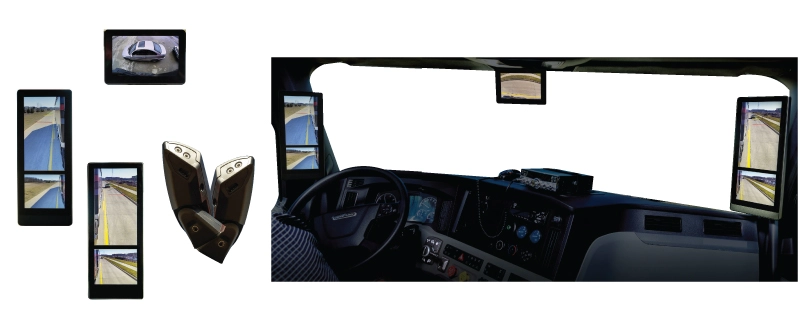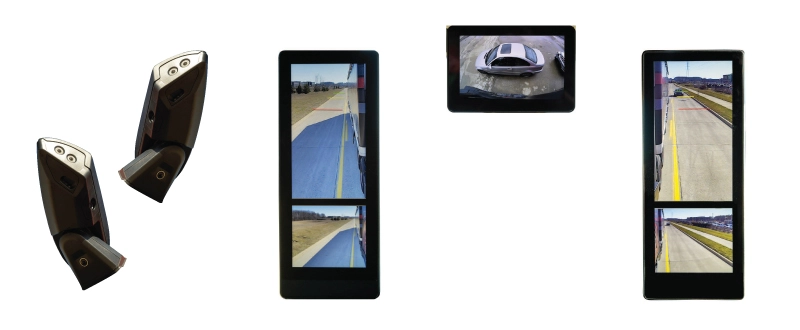
Luxury Cars and the Rise of Digital Rearview Mirrors: A Clearer View of the Future
For decades, the rearview mirror has been a steadfast companion for drivers, offering a glimpse into the world behind the vehicle. However, in the realm of luxury automobiles, innovation never rests. The traditional mirror is being reimagined, replaced by sophisticated digital rearview mirrors that promise enhanced visibility, improved safety, and a touch of futuristic elegance. This article delves into the technology, benefits, and implications of digital rearview mirrors in the luxury car market.
The Evolution of Rearview Technology
The conventional rearview mirror, a simple yet effective device, relies on a reflective surface to provide a direct view of the scene behind the car. While functional, it has limitations. Obstructions such as passengers, headrests, and the vehicle’s structure itself can create blind spots, hindering the driver’s ability to perceive potential hazards.
The advent of digital rearview mirrors marks a significant leap forward. These systems employ a camera mounted on the rear of the vehicle to capture a live video feed, which is then displayed on a high-resolution screen where the traditional mirror would normally be. This approach offers several key advantages over its analog predecessor.
Key Benefits of Digital Rearview Mirrors
-
Unobstructed View: Digital rearview mirrors eliminate obstructions caused by passengers, cargo, or the vehicle’s design. The camera provides a clear, wide-angle view, free from the limitations of a physical mirror. This is particularly beneficial in vehicles with small rear windows or those frequently carrying large loads.
-
Enhanced Visibility in Low-Light Conditions: Digital rearview mirrors often incorporate advanced image processing techniques that enhance visibility in low-light conditions. The camera can capture more light than the human eye, and the system can adjust brightness and contrast to provide a clearer image in dimly lit environments or during nighttime driving.
-
Wider Field of View: The camera used in digital rearview mirrors typically offers a wider field of view compared to a traditional mirror. This allows the driver to see more of the surrounding environment, reducing blind spots and improving awareness of vehicles approaching from the sides.
-
Reduced Glare: Digital rearview mirrors can be equipped with anti-glare technology that automatically reduces the intensity of bright headlights from vehicles behind. This feature minimizes distractions and improves driver comfort, particularly during nighttime driving.
-
Integration with Advanced Driver-Assistance Systems (ADAS): Digital rearview mirrors can be seamlessly integrated with other ADAS features, such as blind-spot monitoring and rear cross-traffic alert. The mirror can display alerts or warnings directly within the driver’s line of sight, enhancing safety and preventing accidents.
-
Customizable Display Options: Some digital rearview mirror systems offer customizable display options, allowing drivers to adjust brightness, contrast, and zoom levels to suit their preferences. This level of personalization ensures optimal visibility in various driving conditions.
-
Aesthetic Appeal: Digital rearview mirrors contribute to the modern and technologically advanced aesthetic of luxury car interiors. The sleek display screen replaces the traditional mirror, creating a cleaner and more sophisticated look.
Luxury Car Manufacturers Embracing the Technology
Several leading luxury car manufacturers have already incorporated digital rearview mirrors into their vehicles. Cadillac was among the first to introduce the technology with its CT6 sedan, followed by other models like the Escalade. Land Rover offers the "ClearSight Rear View Mirror" in the Range Rover and other models, while Audi has implemented similar systems in its e-tron and other high-end vehicles.
These manufacturers recognize that digital rearview mirrors align with the expectations of luxury car buyers, who demand cutting-edge technology, enhanced safety features, and a premium driving experience.
Challenges and Considerations
Despite the numerous benefits, digital rearview mirrors also present some challenges and considerations:
-
Image Quality and Latency: The quality of the video feed is crucial for the effectiveness of a digital rearview mirror. Factors such as camera resolution, image processing algorithms, and display quality can affect the clarity and detail of the image. Latency, or the delay between the camera capturing the image and it being displayed on the screen, can also be a concern. A significant delay can disorient the driver and make it difficult to judge distances accurately.
-
Adaptation and Familiarity: Drivers accustomed to traditional rearview mirrors may require some time to adapt to the digital display. The depth perception and spatial awareness provided by a physical mirror can be different from that of a digital screen. Manufacturers are addressing this issue by designing intuitive interfaces and providing clear visual cues to help drivers adjust.
-
Reliability and Durability: The camera and display components of a digital rearview mirror must be robust enough to withstand the rigors of daily use. They should be resistant to vibration, temperature extremes, and moisture. Regular maintenance and occasional repairs may be necessary to ensure optimal performance.
-
Cost: Digital rearview mirror systems are typically more expensive than traditional mirrors, which can contribute to the overall cost of the vehicle. However, as the technology becomes more widespread, prices are likely to decrease.
-
Potential for Distraction: While designed to enhance safety, digital rearview mirrors could potentially distract drivers if not implemented properly. The brightness and placement of the display should be carefully calibrated to minimize glare and avoid diverting the driver’s attention from the road ahead.
The Future of Rearview Technology
The future of rearview technology in luxury cars is likely to be even more innovative and integrated. We can expect to see further advancements in camera technology, image processing, and display resolution. Augmented reality (AR) features could be incorporated into the digital rearview mirror, overlaying important information such as navigation cues, speed limits, and hazard warnings onto the video feed.
Integration with advanced driver-assistance systems will also become more seamless. The digital rearview mirror could serve as a central hub for displaying information from various sensors and cameras around the vehicle, providing the driver with a comprehensive view of their surroundings.
Furthermore, the rise of autonomous driving technology could lead to even more radical changes in rearview mirror design. In fully autonomous vehicles, the traditional need for a rearview mirror may diminish, as the vehicle’s sensors and computers will handle all aspects of perception and navigation. However, digital displays could still be used to provide passengers with information about the vehicle’s surroundings and the status of the autonomous driving system.
Conclusion
Digital rearview mirrors represent a significant advancement in automotive technology, offering numerous benefits over traditional mirrors in terms of visibility, safety, and convenience. As luxury car manufacturers continue to embrace this technology, it is likely to become a standard feature in high-end vehicles.
While challenges remain in terms of image quality, adaptation, and cost, ongoing innovation and refinement will address these issues and further enhance the capabilities of digital rearview mirrors. The future of rearview technology is bright, with the potential for even more sophisticated and integrated systems that will transform the driving experience and improve safety for all road users. The digital rearview mirror is not just a replacement for its analog predecessor; it’s a window into the future of automotive technology, offering a clearer, safer, and more connected driving experience.
